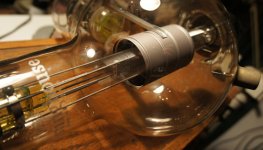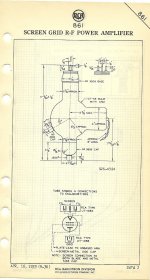The grid on this power triode seems to extend as far outside the anode as it does into the anode.
What is the point of having a grid outside the anode ?
Higher resolution photograph here: Name that Ware November 2011 bunnie's blog
What is the point of having a grid outside the anode ?
Higher resolution photograph here: Name that Ware November 2011 bunnie's blog
Attachments
From what I understand about tubes it is to ensure that the tube is able to cut off completely. Some electrons sneak around the grid to the plate if the grid does not extend far enough past it making it very difficult to stop the electron flow regardless of the negative grid voltage. I could be wrong, but this is what I remember. HTH
The first question is if it is a screen grid or control grid?
Control grid. (it's a triode).
Heat dissipation makes sense, but don't they usually put fins for that ?
From what I understand about tubes it is to ensure that the tube is able to cut off completely. Some electrons sneak around the grid to the plate if the grid does not extend far enough past it making it very difficult to stop the electron flow regardless of the negative grid voltage. I could be wrong, but this is what I remember. HTH

This is the correct explanation based on my long ago involvement with evaluating Svetlana 300B and other DHTs. (The higher the plate voltage, the harder it is to assure full cut off.) Certain brands of 300B that ran fine at 300V absolutely could not be controlled as plate voltage was increased towards 400V, one set of Chinese samples I evaluated could not be fully cut off even with more than -250V (I forget the exact number) on the grid at 400V plate, and in fact consistently ran way when run in amplifiers at this voltage. The big difference between these tubes and ones that worked was that the control grid did not extend past the plate.
Interesting, but these grids are going FAR beyond the plate... electrons with a curvy route??
In the OPs link, someone ID'd the tube as a tetrode...
_-_-bear
It appears to be a triode, I don't see enough supports on the ceramic biscuit in the center for there to be a control grid, looks like all that is required for a filament. This IMHO looks like a fairly high mu, high voltage transmitting triode. Perhaps there is a screen grid we cannot see if it is in fact a tetrode, but the pitch of that grid leads me to believe that what we are seeing is the control grid.
If the tube was intended for very high voltage operation the grid could extend quite far beyond the plate, but this is rather more than I have seen in types I am familiar with like the 300B or the GM70 where it is readily apparent. As memory serves such is also the case with the 211 and 845. The grid extension beyond the plate in these types is typically a few mm or more.. (+/-)
Hokay, the tube in question is an 861 made by RCA and Westinghouse. I have one in my collection. It's called a "screen grid RF power amplifier". It is a tetrode, not a triode. The extended grid that you see is the screen grid. The control grid is inside the screen and does not extend past the plate. It's also a wide spiral design, meaning there is a lot of space between turns. It's connection is at the top of the tube. (bottom in drawing)
Besides whatever electrical reasons why the screen was so extended, there is surely a mechanical reason as well. This is a large tube with the screen wound on four long rods supported at both ends. By extending the windings at both ends structural integrity is increased as well as dissipation. The name would suggest that the screen does most of the work. It's little brother the 860 is very similar but more then twice as small.
Besides whatever electrical reasons why the screen was so extended, there is surely a mechanical reason as well. This is a large tube with the screen wound on four long rods supported at both ends. By extending the windings at both ends structural integrity is increased as well as dissipation. The name would suggest that the screen does most of the work. It's little brother the 860 is very similar but more then twice as small.
Attachments
Last edited:
Since it is definitely the screen grid presumably it is there mainly to increase rigidity, but perhaps it also helps to isolate the plate from the other electrodes..
Certainly a very fine pitch for a screen grid, learn something new every day..
My previous comments are only valid WRT power triodes, they do not apply at all with a tetrode such as this..
Certainly a very fine pitch for a screen grid, learn something new every day..
My previous comments are only valid WRT power triodes, they do not apply at all with a tetrode such as this..
- Status
- This old topic is closed. If you want to reopen this topic, contact a moderator using the "Report Post" button.
- Home
- Amplifiers
- Tubes / Valves
- Why does the grid extend so far beyond the anode ?

